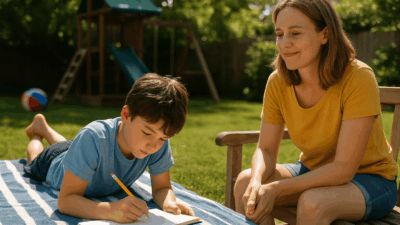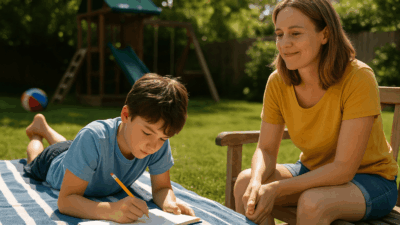“Describe your summer holiday”.
For many children, a prompt like this is a recipe for a panic-inducing stare at a blank page. Creative writing is often the most daunting part of the 11+ English exam. It’s a test not just of grammar and vocabulary, but of imagination, structure, and the ability to engage a reader under intense time pressure.
The secret to overcoming this fear is to move beyond boring, generic prompts. A great story starts with a great idea – a spark that ignites curiosity and makes a child want to write.
At elevenplus.com, we believe every child has a creative voice. They just need the right key to unlock it. This guide provides 10 unique prompts across the different types of writing tasks your child might face, designed to kickstart their imagination and make writing fun again.
In this guide, you will find:
- 10 unique writing prompts, categorized by task type.
- Expert tips on how to use these prompts to plan a great story.
- A simple three-step structure to give their writing focus.
10 Prompts to Spark Imagination & Build Skills
“Creative Writing” isn’t just one thing. The 11+ can ask your child to write a narrative, a description, or from a unique perspective. Here are prompts designed to build skills in each area.
Category 1: Narrative Story Starters
These prompts are designed to kickstart a story with a clear problem or mystery.
- The Backwards Clock: You find an old pocket watch in your grandparent’s attic. When you wind it up, it starts ticking backwards. Write a story about what happens next.
- The Swapped Lunchbox: You open your lunchbox at school to find it’s not yours. Instead of your usual sandwiches, it contains a strange glowing gadget and a note that says, “Help me.”
- The Message in a Bottle: While walking on a beach, you find a bottle washed up on the shore. Inside is not a message, but a single, strange-looking key and a map of your own town.
Category 2: Descriptive Writing Tasks
These prompts test your child’s ability to use vivid language (adjectives, similes, metaphors) to paint a picture with words.
- The Abandoned Theme Park: You and your friends discover a path in the woods that leads to an old, abandoned theme park. Describe what you see, hear, and smell as you step through the gates for the first time.
- The First Person on Mars: You are an astronaut and have just become the first person to step onto the surface of Mars. Describe your first five minutes. Focus on the sights, sounds, and feelings of being on another planet.
- The Day the Colours Disappeared: You wake up one morning to find the entire world is in black and white. Describe your familiar bedroom or street as it looks now, focusing on the textures, shapes, and shadows you never noticed before.
Category 3: Writing from a Different Perspective
These tasks challenge your child to step into someone else’s shoes (or paws!) and write from their point of view.
- The Animal’s Perspective: Write a story from the point of view of a cat on the day its family moves house. What do you see, smell, and feel? What do you think of all the boxes and strange people?
- The Talking Statue: You are a statue of a famous historical figure in the town square. For one hour only, you can see, hear, and think like a human. Describe the modern world you observe from your pedestal.
Category 4: Personal Experience & Recounts
These prompts ask your child to draw on their own emotions and experiences to write a compelling piece.
- The Magical Recipe Book: Write about a time you helped cook or bake something special in the kitchen. Describe the process, the smells, the sounds, and how you felt when you tasted the final creation.
- The Secret Door: Imagine you have found a secret door in your house leading to a place you’ve always dreamed of. Write a diary entry about your discovery and your feelings of excitement and anticipation.
How to Use These Prompts: The 3-Step Story Plan
A great idea is just the start. To turn a prompt into a high-scoring story, your child needs structure. Before they start writing, encourage them to take three minutes to plan using this simple Beginning-Middle-End framework.
1. The Beginning:
- Introduce your main character. Who are they?
- Set the scene. Where and when is the story taking place?
- Introduce the problem or mystery. This is usually the prompt itself.
2. The Middle:
- Develop the plot. What does the character do to try and solve the problem? What challenges or obstacles do they face?
- Build suspense or excitement. Raise the stakes. Make the reader want to know what happens next.
3. The End:
- The Climax: This is the most exciting part of the story where the problem is faced head-on.
- The Resolution: How is the problem solved? What is the outcome?
- A Concluding Thought: End with a final sentence that summarises the character’s feelings or what they have learned.
From Blank Page to Full Story
The goal of these prompts is to show your child that they are full of creative ideas. Regular practice with interesting starting points builds confidence and writing stamina, turning the creative writing task from a source of fear into an opportunity to shine.

Want to take the next step? Our 11+ Creative Writing packs provide detailed story plans, model answers, and examiner’s tips to help your child understand exactly what it takes to write a top-scoring story.
➡️ Explore our Creative Writing Practice Packs today and give your child the structure they need to bring their brilliant ideas to life.



